FREE COMIC BOOK DAY: A Sample Platter.
By Jeb D.
There’s no possible way for me to have read all the Free Comic Book Day releases (there are more and more companies jumping onboard every year), but since I know many retailers will still have books available over the next week or so, here’s a few you might consider looking for.
 Owly (Top Shelf) It’s awfully hard to describe Andy Runton’s Owly without selling short the best all-ages read since Jeff Smith’s Bone. These wordless stories of the little owl called Owly, and his forest friends, are as sweet and charming as you’d expect from the cover illustration, but they’re far from juvenile. The pacing rewards serious reading, and Runton’s view of the animal thought process makes his characters seem not so much “human” as what we humans wish we could be: straightforward and understanding. “Breakin’ the Ice” is a typical Owly story, with lessons learned about loyalty and making friends. Runton uses all 32 pages to tell his tale, and none of it feels padded or wasted. And, then, there’s just something about the rough feel of the lovely heavy paper the book is printed on that just seals the deal for old-school types like myself. Don’t miss your chance to sample Owly, and for heaven’s sake, if you have young kids, share this with them. You’ll both get a lot out of it.
Owly (Top Shelf) It’s awfully hard to describe Andy Runton’s Owly without selling short the best all-ages read since Jeff Smith’s Bone. These wordless stories of the little owl called Owly, and his forest friends, are as sweet and charming as you’d expect from the cover illustration, but they’re far from juvenile. The pacing rewards serious reading, and Runton’s view of the animal thought process makes his characters seem not so much “human” as what we humans wish we could be: straightforward and understanding. “Breakin’ the Ice” is a typical Owly story, with lessons learned about loyalty and making friends. Runton uses all 32 pages to tell his tale, and none of it feels padded or wasted. And, then, there’s just something about the rough feel of the lovely heavy paper the book is printed on that just seals the deal for old-school types like myself. Don’t miss your chance to sample Owly, and for heaven’s sake, if you have young kids, share this with them. You’ll both get a lot out of it.
RATING: 
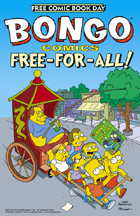 Bongo Comics Free- For-All (Bongo—duh!) No question, for those who hate “decompressed” storytelling, the best “bargain” of Free Comic Book Day was the Bongo Comics Free- For-All. Bongo has been publishing “The Simpsons” comics for over a decade, with a record of consistently funny stuff that the actual TV show hasn’t matched for a few years now. This book’s no exception: every page is absolutely crammed with the big gags and silly throwaways that were the hallmark of the TV series’ prime, and anyone who finds the show a bit stale now can recapture the old magic with these great comics. Besides a complete Simpsons story, we get a nice helping of the superhero parodies these guys do so well, plus “Backstage at Bongo Comics Group”, with a surprise guest star! And, c’mon—in the book’s first panel, Comic Book Guy is reading “Archie Disassembled”, and sighing “Big Ethel kills Moose to get Jughead’s attention? Oh, Brian Michael Bendis, you’ve done it again!” You can’t possibly resist that.
Bongo Comics Free- For-All (Bongo—duh!) No question, for those who hate “decompressed” storytelling, the best “bargain” of Free Comic Book Day was the Bongo Comics Free- For-All. Bongo has been publishing “The Simpsons” comics for over a decade, with a record of consistently funny stuff that the actual TV show hasn’t matched for a few years now. This book’s no exception: every page is absolutely crammed with the big gags and silly throwaways that were the hallmark of the TV series’ prime, and anyone who finds the show a bit stale now can recapture the old magic with these great comics. Besides a complete Simpsons story, we get a nice helping of the superhero parodies these guys do so well, plus “Backstage at Bongo Comics Group”, with a surprise guest star! And, c’mon—in the book’s first panel, Comic Book Guy is reading “Archie Disassembled”, and sighing “Big Ethel kills Moose to get Jughead’s attention? Oh, Brian Michael Bendis, you’ve done it again!” You can’t possibly resist that.
RATING: 
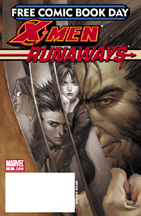 X-Men/Runaways (Marvel) Though it’s billed on the cover as X-Men/Runaways, Marvel’s FCBD offering was a rather variable mixed bag. The “title” story is a brand-new, but familiar “super-teams-meet-and-fight-and-make-up” tale, with the X-Men and Runaways at cross purposes for 11 pages of smash-and-bash, enlivened by Brian K. Vaughan’s always-priceless dialog, and the wild art of Skottie Young (whose inspiration for the X-Men seems to have been the Q-Type series of PVC toys). There’s a limit to how much you can expect out of a story like this—at one point, Gert sits on the sidelines moaning “Wake me when the fight scene’s over”—but Runaways fans won’t want to miss it. It’s followed by another of Chris Eliopoulos and Marc Sumerak’s cute, Calvin and Hobbes-inspired stories of “Franklin Richards: Son of a Genius.” There’s an introduction to the new all-ages “Marvel Adventures Avengers” series—featuring such well-known “Avengers” as Storm (?) and Giant-Girl (??)—with some nicely old-school art from Manuel Garcia and Scott Koblish. The last feature is the real oddity: an 11-page text piece retelling the first 80-some issues of Ultimate Spider-Man, illustrated with panels from the series. Whether this will actually help new readers “get on board” I have no idea, but I suppose getting it for free’s not so bad, since Marvel actually charged money for similar books devoted to Squadron Supreme and Astonishing X-Men. Great Jo Chen cover, by the way.
X-Men/Runaways (Marvel) Though it’s billed on the cover as X-Men/Runaways, Marvel’s FCBD offering was a rather variable mixed bag. The “title” story is a brand-new, but familiar “super-teams-meet-and-fight-and-make-up” tale, with the X-Men and Runaways at cross purposes for 11 pages of smash-and-bash, enlivened by Brian K. Vaughan’s always-priceless dialog, and the wild art of Skottie Young (whose inspiration for the X-Men seems to have been the Q-Type series of PVC toys). There’s a limit to how much you can expect out of a story like this—at one point, Gert sits on the sidelines moaning “Wake me when the fight scene’s over”—but Runaways fans won’t want to miss it. It’s followed by another of Chris Eliopoulos and Marc Sumerak’s cute, Calvin and Hobbes-inspired stories of “Franklin Richards: Son of a Genius.” There’s an introduction to the new all-ages “Marvel Adventures Avengers” series—featuring such well-known “Avengers” as Storm (?) and Giant-Girl (??)—with some nicely old-school art from Manuel Garcia and Scott Koblish. The last feature is the real oddity: an 11-page text piece retelling the first 80-some issues of Ultimate Spider-Man, illustrated with panels from the series. Whether this will actually help new readers “get on board” I have no idea, but I suppose getting it for free’s not so bad, since Marvel actually charged money for similar books devoted to Squadron Supreme and Astonishing X-Men. Great Jo Chen cover, by the way.
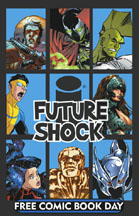 Future Shock (Image) Though there was actually a lot of brand-new material from a number of companies at FCBD this year, Image seems pretty impressed with the fact that they didn’t just put out “some old reprint of a popular title”. Instead, they excerpted four pages each from upcoming issues of their key books, most of which have been around long enough that it’s hard to judge them out of context—I mean, by now, most regular comics readers know whether or not they’re interested in Spawn or Savage Dragon, and I think it takes more than a snippet to grab a new reader (I might also mention that readers of Invincible, in particular, should be prepared for spoilers). The book provides a nice introduction to some of Image’s newer titles, though: if you’ve never seen the Kirby cosmic homage that is Godland, you certainly should take a peek, and Fear Agent fans can judge if new artist Jerome Opena’s as good a fit for the comic as Tony Moore. Also featured are selections from the venerable Shadowhawk, Witchblade, and Noble Causes.
Future Shock (Image) Though there was actually a lot of brand-new material from a number of companies at FCBD this year, Image seems pretty impressed with the fact that they didn’t just put out “some old reprint of a popular title”. Instead, they excerpted four pages each from upcoming issues of their key books, most of which have been around long enough that it’s hard to judge them out of context—I mean, by now, most regular comics readers know whether or not they’re interested in Spawn or Savage Dragon, and I think it takes more than a snippet to grab a new reader (I might also mention that readers of Invincible, in particular, should be prepared for spoilers). The book provides a nice introduction to some of Image’s newer titles, though: if you’ve never seen the Kirby cosmic homage that is Godland, you certainly should take a peek, and Fear Agent fans can judge if new artist Jerome Opena’s as good a fit for the comic as Tony Moore. Also featured are selections from the venerable Shadowhawk, Witchblade, and Noble Causes.
 Free Scott Pilgrim (Oni Press). It’s hard to convey just what makes Scott Pilgrim such a brilliant comic. Writer/artist Bryan Lee O’Malley calls Scott Pilgrim “an indecisive loser-hero hybrid”: 23-year-old Scott lives in Canada, has a band, no job, some friends who mostly like him, and girlfriend trouble—well, that’s if you call having a girlfriend whose Seven Evil Ex-Boyfriends need to be fought and defeated trouble. While videogame references are common (and often cited in reviews of the book), the moments that make Scott Pilgrim work are the sort of everyday details that Scott notices (or obsesses over), that most of us share, no matter our age or background. In the first scene, Scott’s driving his friends to distraction trying to select the best drink to buy to take to the movies. I won’t spoil any of it, but his thought process, soft drink analysis, and final payoff are both absurd and inevitable. And then, just when we have the book pegged as an amusing “slice of life” story, the trip to the movies is interrupted by the movie posters of a famous teen actress all coming to life and attacking Scott, whose “mad fighting skills” are useless because he “can’t hit a 16-year-old girl!” So far, O’Malley has put out two Scott Pilgrim graphic novels, with a third due any day. Whether you’re a fan of superheroes, manga, indies, doesn’t matter—you’ve gotta try Scott Pilgrim. The backup feature, “Fearless Griggs” is less successful: Andy Helms has come up with a melding of “The League of Extraordinary Gentlemen” and “Gun Fu”, in a drawing style that suggests a very sketchy Mike Mignola “Lobster Johnson” adventure, and it feels far less engaging than any of those. But, hey, it’s a free story in a free Scott Pilgrim book—a bargain by definition.
Free Scott Pilgrim (Oni Press). It’s hard to convey just what makes Scott Pilgrim such a brilliant comic. Writer/artist Bryan Lee O’Malley calls Scott Pilgrim “an indecisive loser-hero hybrid”: 23-year-old Scott lives in Canada, has a band, no job, some friends who mostly like him, and girlfriend trouble—well, that’s if you call having a girlfriend whose Seven Evil Ex-Boyfriends need to be fought and defeated trouble. While videogame references are common (and often cited in reviews of the book), the moments that make Scott Pilgrim work are the sort of everyday details that Scott notices (or obsesses over), that most of us share, no matter our age or background. In the first scene, Scott’s driving his friends to distraction trying to select the best drink to buy to take to the movies. I won’t spoil any of it, but his thought process, soft drink analysis, and final payoff are both absurd and inevitable. And then, just when we have the book pegged as an amusing “slice of life” story, the trip to the movies is interrupted by the movie posters of a famous teen actress all coming to life and attacking Scott, whose “mad fighting skills” are useless because he “can’t hit a 16-year-old girl!” So far, O’Malley has put out two Scott Pilgrim graphic novels, with a third due any day. Whether you’re a fan of superheroes, manga, indies, doesn’t matter—you’ve gotta try Scott Pilgrim. The backup feature, “Fearless Griggs” is less successful: Andy Helms has come up with a melding of “The League of Extraordinary Gentlemen” and “Gun Fu”, in a drawing style that suggests a very sketchy Mike Mignola “Lobster Johnson” adventure, and it feels far less engaging than any of those. But, hey, it’s a free story in a free Scott Pilgrim book—a bargain by definition.
RATING: 
Size Isn’t Everything in Spiderman Unlimited
by
 Graphic novels are clearly the wave of the future, perhaps even the salvation of the art-form. The number of comic readers has dropped drastically in the last generation and astronomically from the one before that. Many reasons for this are clear, some are not. The results cannot be doubted. Getting the books back into bookstores and on newsstands is vital and the novel length issues are clearly the visible path. Still, there is still a place for the short story.
Graphic novels are clearly the wave of the future, perhaps even the salvation of the art-form. The number of comic readers has dropped drastically in the last generation and astronomically from the one before that. Many reasons for this are clear, some are not. The results cannot be doubted. Getting the books back into bookstores and on newsstands is vital and the novel length issues are clearly the visible path. Still, there is still a place for the short story.
In the 1950s and 1960s, Marvel Comics and its predecessor often divided issues into two disparate tales, and in the Golden Age virtually every comic was composed of many very short stories. Serialized stories have almost driven this type of comic into oblivion. So much so that when one runs across such attempts, and especially when done with elan and style as in this issue, they become a quiet joy.
A few years back, The Marvels took a look, for several issues quite an excellent look, at what life would be like for non super powered individuals in a world that had a population of superheroes and supervillains. Here are two short stories with the point of view from victims or innocent bystanders, depending on your interpretation. This is a subject rich and ripe, and I find it surprising that we get so few tales like this.
In this issue, children who idolize Spiderman, and the wife of one of his major opponents give us a glimpse into their world. They are handled with sympathy and dignity and we can all only hope that more such works will be brought out and not just from this title.
RATING: 
Whose Side Are You On? If it’s the side of entertaining comics, then pick up CIVIL WAR #1
By Jeb D.
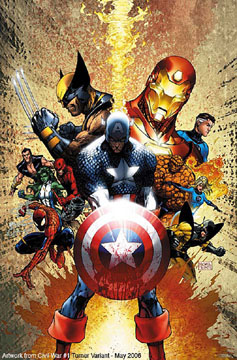 The giant crossover event is an important tool in the marketing arsenal for Marvel and DC—monthly comic sales suffer from an attrition that requires these “jump-starts” on a regular basis. Sometimes the level of hype is so great that the actual comic becomes almost an afterthought. Sometimes that’s no great loss—too many of these events are less than the sum of their parts. Civil War, though, is clearly intended to be more than this year’s 10-day wonder, and so far, writer Mark Millar and artist Steve McNiven are delivering.
The giant crossover event is an important tool in the marketing arsenal for Marvel and DC—monthly comic sales suffer from an attrition that requires these “jump-starts” on a regular basis. Sometimes the level of hype is so great that the actual comic becomes almost an afterthought. Sometimes that’s no great loss—too many of these events are less than the sum of their parts. Civil War, though, is clearly intended to be more than this year’s 10-day wonder, and so far, writer Mark Millar and artist Steve McNiven are delivering.
The New Warriors, being filmed by a reality TV show, take the fight to a group of supervillains too close to a school, and when the villain Nitro sets off an explosion, hundreds of people, many of them children, are killed. In its wake comes a call for the registration of superheroes, to provide some sort of controls over their power, and we see the various Marvel characters start to take sides for or against the legislation. Of course, collateral damage of this type is often implicit in superhero comics, but rarely addressed, making it possible to ask “OK, but what’s so special about this time?” Really, though, that’s the way life often is: something that slipped past us many times before suddenly comes into focus when one voice, or set of circumstances, brings it to our attention.
The idea of government sanctions on superheroes is hardly new—it’s been a staple of the X-Men series for over thirty years—but typically, in stories from “Days of Future Past” to “Dark Knight Returns,” it’s been driven by evil villains or cowardly, small-minded bureaucrats. This time, Millar’s posed the situation as one where a good percentage of the heroes are going to find themselves in support of such action. Thus the Civil War, which is going to be fought along lines of ideology, not some cosmic “shirts and skins” game. While the question of how much liberty we’d give up for more security is addressed in arenas more sophisticated than a superhero comic, Millar and company are using it as the foundation for a story that, on its own terms, may prove to be relatively profound.
The artwork is really stunning. Steve McNiven’s star has risen fast at Marvel, and this is the payoff. It’s about as “widescreen” as a comic can be: there’s no conventional “grids”, as every page is made up of panels that fill the width of the page (some complete, some broken into two or three smaller ones), and it has precisely the “epic” feel that made Bryan Hitch’s Authority work feel so thrilling. He shines in the two big setpieces: the initial attack and destruction of the school moves from slapstick to tragedy almost faster than we can read it, and the book’s climax features what is, with all due respect to Steve Epting, the best Captain
Deciding which hero will line up where is not a simple issue: most of these characters have been written by many dozens of writers, decade after decade, with enough variety in characterization that it’s possible to find equally good reasons for them to be in favor of registration or against it (for example, Cap is clearly positioned as opposing registration because he stands for America’s “ideals”, more than any specific law; but it would have been just as easy to write him as a soldier doing his duty by upholding the legislation). That gives Millar a lot of leeway, and heightens the suspense for future issues.
The fact that Millar’s more at home in the Ultimate Marvel Universe than the 616 one peeks through here and there: Captain America’s dialog has the “right out of the trenches” tone that we associate more with recently-revived Ultimate Cap than the 616 Cap who’s had a few more years to get used to modern life; his Hank Pym also leans more toward the rather disturbed Ultimate version (though the 616 Pym has certainly been portrayed as an unpleasant SOB more than once). Overall, though, Millar seems to have a good blueprint for what’s ahead, and he actually makes it feel that there will be real weight and consequences for the characters as they choose up sides.
And while I specifically don’t want to review the marketing here, it’s been made clear that the Marvel Universe won’t kiss and make up when this is all over—they’re laying seeds for what may be a very interesting shift in focus for all these characters in the months and years to come. A very promising beginning.
RATING: 
Wormwood – Gentleman Corpse: The Taster: Yes, In Fact Ben Templesmith Is a Helluva Writer
By Mark Wheaton
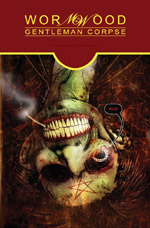 “Yes, I miss the old Medusa. The one that’d rip your head off, piss down the neck hole as part of the golden shower show and proceed to give the spasming corpse a 10 minute lapdance and still expect him to tip you. Aaah, those were the days.”
“Yes, I miss the old Medusa. The one that’d rip your head off, piss down the neck hole as part of the golden shower show and proceed to give the spasming corpse a 10 minute lapdance and still expect him to tip you. Aaah, those were the days.”
After admiring Ben Templesmith’s unique artwork in everything from “30 Days of Night” to “Fell,” the artist now takes on the role of writer as well with “Wormwood – Gentleman Corpse: The Taster,” an obtuse, Warren Ellis-channeling tale of a corpse/tippling gadabout named Wormwood with a pentagram on his forehead and a mechanical man he built as a drinking buddy named Mr. Pendulum. Together, at least in #0, they fight a triffid-like plant spore that erupts out of the patrons of a strip club run by Medusa. Sounds manic, huh? But, does it work?
Oh, hellz yeah.
Yes, it is pretty dismissive to suggest Templesmith is channeling Ellis here, but his clever and charming Wormwood (when a stripper/ex-lover blows him off, he retorts: “You don’t just grow out a necrophilia fetish overnight, do you?”) is a jovial, Spider Jerusalem-tinged version of John Constantine, but done with enough well-written humor that it feels like something new. Matching Templesmith’s cartoonishly evil (evilly cartoonish?) artwork, the jocular tone makes for a very fun first outing.
And the plot? Not much of one in #0, really – as spare as Templesmith’s art. Wormwood is drinking at a strip club when the triffid-thing breaks out of more than one patron. He soon realizes the bartender is a demon and is masturbating into the beer lines and it’s up to Wormwood to destroy him. And then use a bucket of Agent Orange to knock out all the triffids. But getting there really is half the fun as Wormwood espouses like Sherlock Holmes on a bender as he figures out what’s going on.
Coupled with the new IDW magazine and the better-than-average “30 Days of Night: Dead Space,” IDW finds another solid book here that could actually turn into something rather fun. An excellent beginning, certainly, and kudos to Templesmith.
RATING: 
The Infinite Crisis is over, and thus not all that infinite…
By Graig
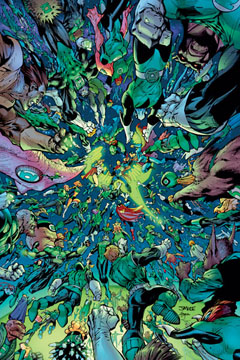 Infinite Crisis has achieved what was intended for it. Oh, perhaps storytelling-wise, but more so by pushing sales up, getting fans excited, getting fans angry, getting the rumour mill going, and in general just getting attention you can bet were it’s objectives from the get go. It’s been a divisive experiment – even if the division is whether you’re getting the George Perez covers or the Jim Lee covers – and now that it’s over, the fans can assess the damage, and DC can slap themselves on the back and say “mission accomplished”.
Infinite Crisis has achieved what was intended for it. Oh, perhaps storytelling-wise, but more so by pushing sales up, getting fans excited, getting fans angry, getting the rumour mill going, and in general just getting attention you can bet were it’s objectives from the get go. It’s been a divisive experiment – even if the division is whether you’re getting the George Perez covers or the Jim Lee covers – and now that it’s over, the fans can assess the damage, and DC can slap themselves on the back and say “mission accomplished”.
The final issue of the mini-series was the first book I read when I got last weeks’ stash of new books home. I read it, and then reread it, and formulated an opinion, which was that it was an improvement over the previous three issues but I still didn’t like it. Once again there was disjointed artwork, strange characterizations, unclear action sequences, and an overwhelming sense of busyness, not to mention the pathetic resolution to last week’s Villains United Special. But lest I begin to repeat myself, I thought I should instead take a look at the series as a whole, and perhaps approach the book from a different perspective. And, after doing so, I was surprised… what was, issue-by-issue, a rather disorganized mess of ideas and sequences, gels together as a more unified single story when read as such.
You see, I had heretofore been approaching Infinite Crisis from the back end, reading the series from the perception of someone who had been led into it from all the back door channels. From the OMAC Project to Adam Strange to JSA Classified to regular series issues of Wonder Woman or Superman, all of these storylines (and more) brought the reader into the Crisis looking at it from a specific angle (or many specific angles), be it intergalactic war surrounding Rann and Thanagar or Superboy’s isolating himself from the Teen Titans. The problem is that those stories all wrap into and are eclipsed by the larger event of the Crisis itself. It’s hard to let go of all the fraying threads and just grab onto the core of the cord beneath, but the reason all the connecting storylines seem to be unsatisfying in their resolution is because they don’t matter nearly as much as the main event.
This realization isn’t any easier to bear for those of us that have dropped a dozens to hundreds of dollars on the lead-ins only to have rather flippant resolutions handed to us, but ignoring that, the actual storyline in Infinite Crisis is pretty entertaining and engaging. Sure, if characterization is equal to nutritional value, then the Crisis is the dietary equivalent of a Twinkie, but it’s still full of flavour and it actually does satisfy the craving.
In giving all seven issues a read in one sitting and ignoring the periphery, the core story shines through. Yeah, it’s a little muddled in its execution because of all the facets weaving into it, but they each have their place, even if some don’t fit as easily as others. Although the chief antagonist(s) are revealed and dealt with (Alex Luthor’s resolution is particularly ingenious), there’s the subtext (essentially the point of the story) of heroes losing their way that is dealt with a little too overtly but still comes full circle from start to finish.
It’s a choppy ride overall, but once you get your sea legs, you can really enjoy it.
RATING: 
![]()

The Flash Archives Volume 4
(DC Comics)
by
 In October 1956, in Showcase # 4, a figure dressed in scarlet and gold came bursting out of a strip of film and the Silver Age of comics began. The superhero genre had languished, with little more than Superman and Batman available for years. The revelation of this character rippled through the comic reading public and in a matter of months the genre was reborn.
In October 1956, in Showcase # 4, a figure dressed in scarlet and gold came bursting out of a strip of film and the Silver Age of comics began. The superhero genre had languished, with little more than Superman and Batman available for years. The revelation of this character rippled through the comic reading public and in a matter of months the genre was reborn.
John Broome, an experienced writer from the Golden Age of Captain Marvel, Green Lantern, and The Justice Society, scripted most of the Flash stories from his re-birth until the 1970s. Inventive and surprisingly modern, Broome brought us not just involving plots but villains that were surprising and novel. When meshed with Carmine Infantino’s pencils and Joe Giells’s inks, both Golden Age greats, these books became the epitome of DC comics of this era.
The covers of The Flash were as note worthy as the interiors. Transformed into a mirror or wooden puppet, grappling with a gorilla, evaporated out of his costume, or trapped by the newest villain, The Flash was always eye-catching. It is impossible to imagine a comic fan could walk by the news-stand or comic rack in the drug or grocery store without buying a copy. (Yes, children, one could once buy comics in stores that were not dedicated solely to their sales.) With the possible exception of The Atom’s early covers, none were better.
The DC comics and characters began to turn stale in a few years and many fans began to prefer Marvel books with their angst and personal difficulties. But Marvel could not exist without the DC work that came before. Without the hard creative work of the people involved in these issues, the spark and the audience for the Fantastic Four and Spiderman would have been absent. This volume contains issue # 125 through # 132 (the Silver Age series began with issue # 105). The previous three volumes, this one, and the next two or three represent the creme-de-la-creme of this era, issues that are engaging, witty, creative, and attractive.
I am a big fan of the Archives series, but it does have faults, even here. The basic issue is reprinted sans letter pages, inside and back covers, and ads are redacted. There are reasons within DC for this, without a doubt, but this is a reduction in the product. The paper is whiter than the original which makes the colors seem more garish, however the major detraction is the price. It seems beyond belief that there is no way to bring the price down yet retain the quality of the reproduction and binding. My best recommendation is to seek out lower prices on Ebay or similar on-line sites. It’s worth the effort.
RATING: 
Bizarro World tpb
(DC Comics)
By Graig
 The perception that indie comic creators hate the mainstream, I think, is a false one, owing to a few comics literati that have the public forum to state such claims. If anything most comics creators of all sorts would point to DC or Marvel as what inspired them to venture into this niche business. Sure, along they way they may have lost interest in spandex fights, or they may prefer to tell more insular or personal stories, but it’s a safe bet that somewhere there’s still a fond memory or two of the gaudier four-color world.
The perception that indie comic creators hate the mainstream, I think, is a false one, owing to a few comics literati that have the public forum to state such claims. If anything most comics creators of all sorts would point to DC or Marvel as what inspired them to venture into this niche business. Sure, along they way they may have lost interest in spandex fights, or they may prefer to tell more insular or personal stories, but it’s a safe bet that somewhere there’s still a fond memory or two of the gaudier four-color world.
It’s these people, with their unique perspectives and storytelling abilities that DC has recruited for, so far, two volumes of their Bizarro comics anthologies, the second of which is Bizarro World. Originally released last year in hardcover, the follow-up to Bizarro Comics has just been released in softcover. Over 60 people from all different disciplines (artists, writers, comedians, musicians, directors, producers, actors) have participated in re-conceptualizing DC’s various heroes for the 35 stories in this volume.
Musician Mike Doughty (with art by Danny Hellman) writes about Aquaman as a rather awful open mic musician, jaded by the Boy Wonder’s popularity. Dylan Horrocks and Farel Dalrymple take a less glamorous look at the life of the world’s fastest man. Peter Bagge and Gilbert Hernandez give the Red Bee a sharper image makeover. Kyle Baker goes shopping with Alfred for a new Batmobile. Evan Dorkin and M. Wartella retell Robin’s first appearance, but with a monkey.
The stories are varied in tone, from sombre to silly, off-beat to cutesy. Oddly, a Christmassy theme frequently rears its head throughout, and some stories are inexplicably and unsatisfactorily left “to be continued”. It’s a hodge-podge in the fullest sense, a something to like, something to dislike, and something to be indifferent on, but overall it’s a high-quality collection.
RATING: 
The Complete Calvin and Hobbes
(Andrews McMeel Publishing)
By
 There have been scores of truly great comic strips. Most were created in the 1930s through the 1940s. As the size of the printed strip began to shrink at the newspaper publishers demand, so did the quality of the strips. Calvin and Hobbes, published from 1985 to 1995, was almost certainly the last commanding strip ever created. Certainly there will be strips that many people enjoy. It is conceivable that an adventure strip might show up, that a completely different type of comic will be developed, that some humorous situation strip will be sprung on the unsuspecting public. But that it will reach the levels of acceptance and enjoyment as Calvin and Hobbes is simply impossible.
There have been scores of truly great comic strips. Most were created in the 1930s through the 1940s. As the size of the printed strip began to shrink at the newspaper publishers demand, so did the quality of the strips. Calvin and Hobbes, published from 1985 to 1995, was almost certainly the last commanding strip ever created. Certainly there will be strips that many people enjoy. It is conceivable that an adventure strip might show up, that a completely different type of comic will be developed, that some humorous situation strip will be sprung on the unsuspecting public. But that it will reach the levels of acceptance and enjoyment as Calvin and Hobbes is simply impossible.
Here a young imp and his stuffed tiger flail their way through their introduction to life, mixing reality with daydreams. The love of the very young for every experience is blended with an adult view of humanity’s failings and achievements in a skewed and original amalgam that rings as true as the writings of Dickens or Twain, but with drawings as pure as the driven snow that Calvin often flings himself into with abandon.
In this set of three hard bound books (slipcased), every Calvin and Hobbes strip, daily and Sunday is printed in as high a quality reproduction and binding as one could ever expect to find. Arranged in chronological order, with color illustrations when appropriate, this is a treasure, a truly lovely thing. All the humor, pathos, insight, humanity, love, and creativity is here, and is worthy of your time and shekels. And while it isn’t cheap, it can be had at steep discount at Amazon and is easily found at most bookstores. Miss it and you will regret it.
RATING: 
<
